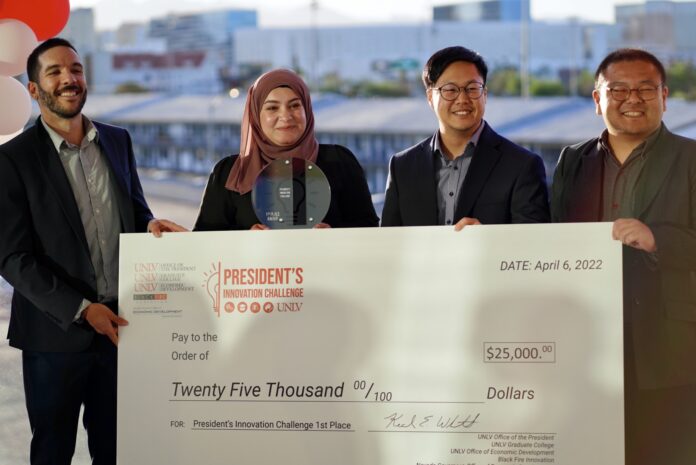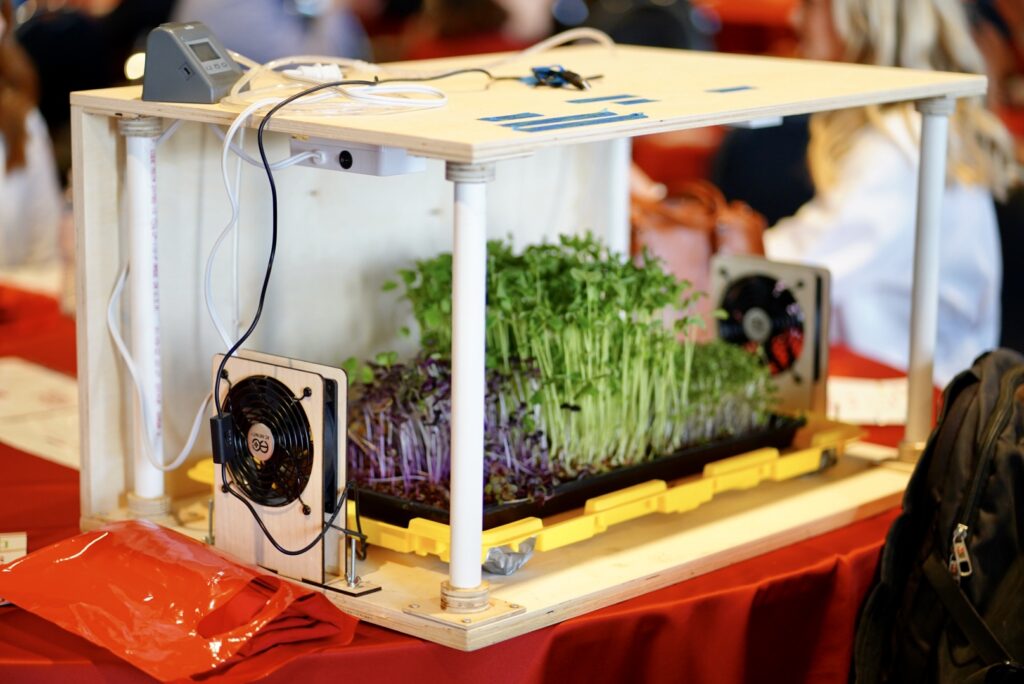
UNLV handed out a first-place trophy and $25,000 to one of the nine finalists in the President’s Innovation Challenge last Wednesday.
UNLV held a shark tank-styled competition where nine finalist teams presented to 12 judges ranging from deans and student body presidents to past Las Vegas Mayors and CEOs of companies. The judges decided who takes home first place and $25,000 as a start-up package.
The top three winners were Aero AI in third place, A More Sustainable World in second place and Essenjays the first ever winners of the President’s Innovation Challenge.
This competition started as a realization that when COVID-19 rolled through the Las Vegas valley, the Strip closed. Employees of the largest industry were now unemployed, which left a city where millions of people travel to an abandoned street with giant billion dollar buildings.
Now that the Strip has reopened, UNLV began searching for a solution to diversify the valley’s economy and make it more resilient.
“How do we make Las Vegas more resilient, more diversified and more sustainable for all of Las Vegas,” Bo Bernhard, vice president of Economic Development said. “Nothing too difficult, just solve a problem that has baffled Las Vegas for more than 50 years that has tried to join the ranks of cities with broader diversity.”
The university started the challenge mid fall with 16 interdisciplinary teams and about 75 students leaped at the challenge. Each team was required to have at least one undergraduate and one graduate student and be cross disciplinary. Not to mention the mentors they had of the teams had to help guide students to their final pitches. The teams faced off in the first round and only nine teams were allowed to progress into the final judging.
Kate Korgan, senior vice provost of Academic Affairs and Bernhard opened the event by explaining the challenge. The teams had seven minutes to pitch their innovation, then the judges were given four minutes to ask their questions to judge their pitch.
Judges had the job of scoring the teams based on five categories. To win, the teams must make sure their problem statement is impactful for the valley. Then how innovative their solution is judged. The teams then go through their proof of concept by usually presenting their physical product. Then based on how scalable the product is judged and overall the presentation is judged.
Robert Rippee, executive director of Black Fire Innovations Hub, introduced all the teams and started with the third-place winner of $10,000 Aero AI.
Aero AI, set out to pilot the next generation of 3D data libraries with drones. This technology is planned to be open sourced and would be able to map out any landscape, which could benefit many fields, like architects, researchers, developers, site managers, and more.
The presenters discuss that the data can be used by geologists, biologists and hydrologists to understand landscapes and even the quality of water. Those in the movie industry can develop a story and view the potential for a site better. And even marketers are expected to view their marketing and plan better with 3D drone mapping.
In second place, the winners of $15,000 for their project, was A More Sustainable World with their patented biopolymer, a biodegradable material, that could replace single use plastics all over the Strip and the campus. The three siblings banded together to find that over the pandemic, single use plastic has gone up even further.
The headquarters and production facility would be in southern Nevada where the biopolymer can be made into different products like dining utensils, containers, and bags. The facility can help diversify the economy in Las Vegas by creating jobs and new revenue streams. Using these biopolymer materials would also reduce the carbon footprint that the Strip produces just with its single use plastics.
One of the presenters pointed out that “Caesars Entertainment used 200 million straws and MGM used 90 million straws last year, which produced 145 million grams of carbon dioxide, a pollutant, that is being produced.”
The winner of the President’s Innovation Challenge is Essenjays and they received the $25,000 prize for the project. The team set out to bring meaningful change to the economy by giving people the chance to grow their own vegetables from home and sell them in the valley. This would aid by introducing nutrients and fresh greens to the desert.
The team is worried about the problems that malnutrition brings to the valley, like obesity, diabetes and cancer. In Nevada, it cost the state $136 million every year in malnutrition related expenses, not to mention the contribution of national healthcare issues that malnutrition brings, that cost the nation hundreds of billions of dollars.
To fight malnutrition, the team designed a fully automated growing unit called Pyia. Pyia can be a stacked self-watering, self-lights, water and electricity efficient, that can grow microgreens indoors in 10 to 11 days. With their growing product, individuals can grow and consume fresh greens at a cheaper cost year round. Extra greens can be sold to local restaurants and can provide the freshest greens as it would only need to travel around the city versus over the nation.

The growing process is all trackable through block-chain technology, allowing consumers of the greens the ability to know exactly who’s batch is the freshest. This technology allows the Southern Nevada Health District (SNHD) to quickly find the source of contaminated growers.
During the intermission where the judges’ scores were being tallied up, Nicole Thomas, GPSA president and judge, said she voted the highest for the Essanjays. Her prediction was correct as she and the rest of the judges voted highly on the self-grower.
The Essenjays were happy to be awarded for the work they’ve put into their project.
“I almost never eat greens, I don’t cook and I don’t know how to garden,” Jacob Gross, an undergraduate on the team who’s been in the restaurant business. “I can literally have this in my kitchen, it can be growing fresh microgreens for me and I can add fresh microgreens to my food.”
Shaimaa Abdelhaleem, a graduate student on the team studying geoscience, said that with the implementation of the blockchain, they would begin to see a larger network of growers, seed sellers, transporters and everyone who’s taken part in the process.
The use of the blockchain is for public record, where the process can be documented and even communicated, explained G Liu, a graduate student on the team. The use of the blockchain is already being used by supply chains and that is to aid in tracking bad batches. Users can track the whole process from seed to plate through the app.
Jonathan Kim, a team member graduate student, came up with the idea of making the self-growers stackable. Many units grow greens, but have made them unable to stack them, but Kim did.
“For a restaurant that wants to grow a bunch of these,” Kim said. “It makes sense that real estate is a premium.”
They were able to execute the product and come to the presented product with the help of someone who took their drawing into a reality.
“These guys came out as part of this challenge, they had the idea that’s really taking their napkin drawing and making it into a box,” RC Wonderly, BlackFire innovation helped Essenjays, “…I showed them how to use the laser cutter and how to 3D print to take their design to another level and have a product to show.”
